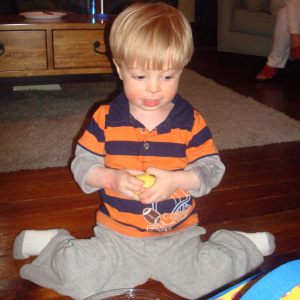As I continue to volunteer and learn more about pediatric occupational therapy, I am finding out so much about things children do that I had never thought might be harmful. One of these things is “W-sitting.” This happens when a child “spreads his hips with his bottom on the floor, his knees bent, and his feet behind him, making a “W” shape with his legs.” (Kendra Ped PT Blog)
I did not know what the big deal was about W-sitting before I started volunteering, but in my time at the clinic I’ve heard several therapists correct a child who was seated in this position. I wondered why it was such a big and even if it was such a big deal, and Kendra’s post about W-sitting provides great discussion about making sure that therapeutic recommendations are actually evidence-based, backed up by fact and ultimately beneficial to all parties involved.
 When a child w-sits he spreads his hips with his bottom on the floor, his knees bent, and his feet behind him, making a “W” shape with his legs.
When a child w-sits he spreads his hips with his bottom on the floor, his knees bent, and his feet behind him, making a “W” shape with his legs.
I’m going to come right out and say it.
I’m a pediatric physical therapist, and I think W-sitting is OK.
Like most physical therapists, I learned in school that W-sitting is bad. Very bad. The worst. When I talk to other physical therapists, even those who don’t treat children, they remember the same thing. In a recent conversation, one colleague recalled the time she came home from PT school in a panic because her then-5-year-old sister was a W-sitter. It is a single, pervasive, clear message taught to physical therapy students everywhere. W-sitting must always be corrected. But why?
The reasons given usually fall into 3 categories:
- W-sitting will cause orthopedic issues such as twisted bones and hip dislocation.
- W-sitting will…
View original post 731 more words